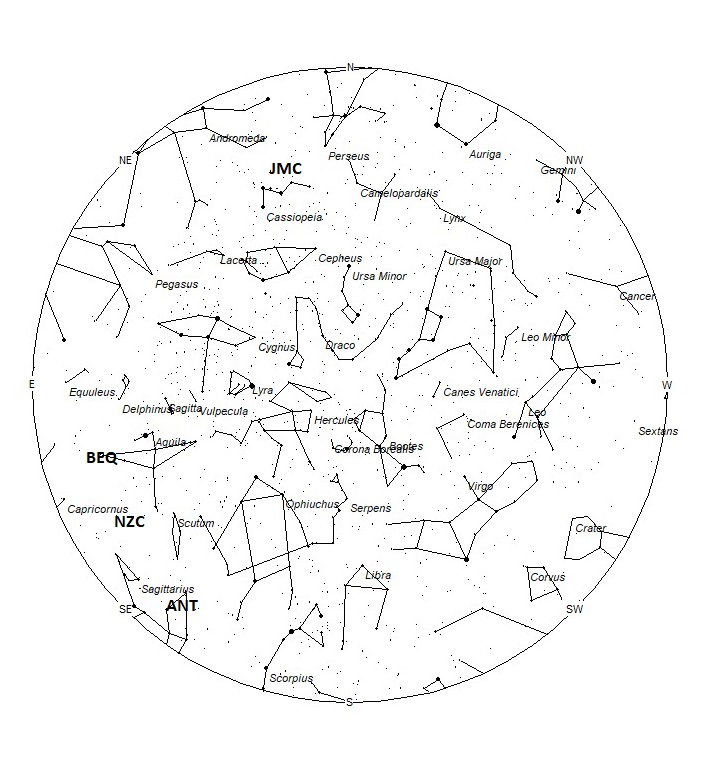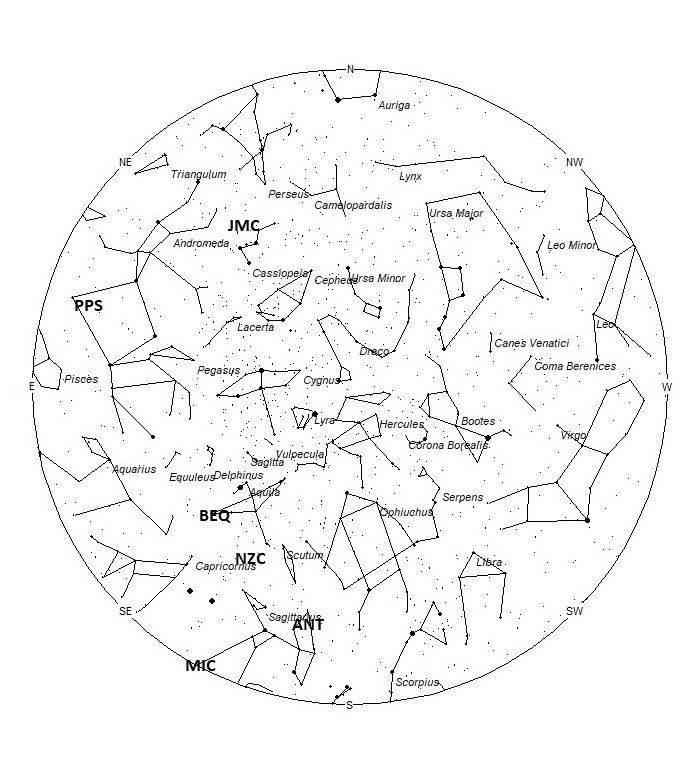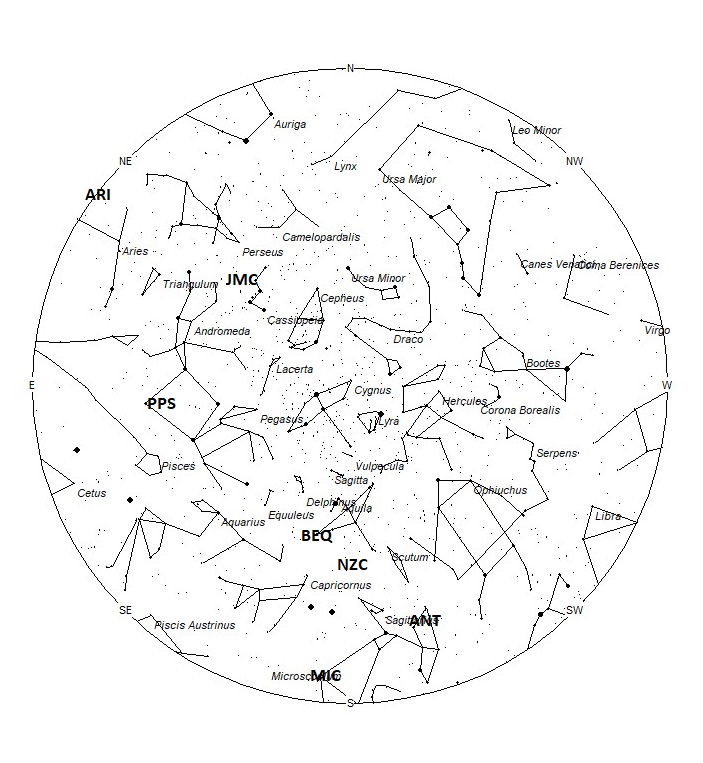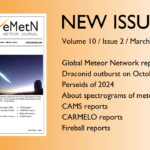During this period the moon reaches its last quarter phase on Saturday June 13th. At this time the moon will rise near 02:00 local summer time (LST) and will remain in the sky the remainder of the morning. This will compromise late morning viewing but successful meteor observations can still be attempted if one keeps the moon out of their field of view. As the week progresses the waning crescent moon will rise later each morning, becoming less of a problem with each passing night. The estimated total hourly meteor rates for evening observers this week is near 2 for those viewing from the northern hemisphere and 3 for those located south of the equator. For morning observers, the estimated total hourly rates should be near 6 as seen from mid-northern latitudes (45N) and 10 as seen from tropical southern locations (25S). Morning rates are reduced during this period due to moonlight. The actual rates will also depend on factors such as personal light and motion perception, local weather conditions, alertness, and experience in watching meteor activity. Note that the hourly rates listed below are estimates as viewed from dark sky sites away from urban light sources. Observers viewing from urban areas will see less activity as only the brighter meteors will be visible from such locations.
The radiant (the area of the sky where meteors appear to shoot from) positions and rates listed below are exact for Saturday night/Sunday morning June 13/14. These positions do not change greatly day to day so the listed coordinates may be used during this entire period. Most star atlases (available at science stores and planetariums) will provide maps with grid lines of the celestial coordinates so that you may find out exactly where these positions are located in the sky. A planisphere or computer planetarium program is also useful in showing the sky at any time of night on any date of the year. Activity from each radiant is best seen when it is positioned highest in the sky, either due north or south along the meridian, depending on your latitude. It must be remembered that meteor activity is rarely seen at the radiant position. Rather they shoot outwards from the radiant, so it is best to center your field of view so that the radiant lies at the edge and not the center. Viewing there will allow you to easily trace the path of each meteor back to the radiant (if it is a shower member) or in another direction if it is a sporadic. Meteor activity is not seen from radiants that are located far below the horizon. The positions below are listed in a west to east manner in order of right ascension (celestial longitude). The positions listed first are located further west therefore are accessible earlier in the night while those listed further down the list rise later in the night.
The radiant (the area of the sky where meteors appear to shoot from) positions and rates listed below are exact for Saturday night/Sunday morning June 6/7. These positions do not change greatly day to day so the listed coordinates may be used during this entire period. Most star atlases (available at science stores and planetariums) will provide maps with grid lines of the celestial coordinates so that you may find out exactly where these positions are located in the sky. A planisphere or computer planetarium program is also useful in showing the sky at any time of night on any date of the year. Activity from each radiant is best seen when it is positioned highest in the sky, either due north or south along the meridian, depending on your latitude. It must be remembered that meteor activity is rarely seen at the radiant position. Rather they shoot outwards from the radiant so it is best to center your field of view so that the radiant lies at the edge and not the center. Viewing there will allow you to easily trace the path of each meteor back to the radiant (if it is a shower member) or in another direction if it is a sporadic. Meteor activity is not seen from radiants that are located below the horizon. The positions below are listed in a west to east manner in order of right ascension (celestial longitude). The positions listed first are located further west therefore are accessible earlier in the night while those listed further down the list rise later in the night.
These sources of meteoric activity are expected to be active this week.
.
The center of the large Anthelion (ANT) radiant is currently located at 18:20 (275) -23. This position lies in northern Sagittarius, 3 degrees northwest of the 3rd magnitude star known as Kaus Borealis (lambda Sagittarii). Due to the large size of this radiant, Anthelion activity may also appear from western Sagittarius and southwestern Ophiuchus as well as Sagittarius. This radiant is best placed near 0200 LST, when it lies on the meridian and is located highest in the sky. Rates at this time should be near 1 per hour as seen from mid-northern latitudes (45 N) and 2 per hour as seen from the southern tropics (S 25). With an entry velocity of 30 km/sec., the average Anthelion meteor would be of slow velocity.
The Northern June Aquilids (NZC) were discovered by Zdenek Sekanina in 1976. These meteors are active from a radiant located at 19:27 (292) -10. This area of the sky is located in southern Aquila, 7 degrees southeast of the 3rd magnitude star known as Al Thalimain Prior (lambda Aquilae). This radiant is best placed near 0300 LST, when it lies on the meridian and is located highest in the sky. With the night of maximum nearly a month away, hourly rates at this time will be less than 1 no matter your location. With an entry velocity of 38 km/sec., the average meteor from this source would be of medium-slow velocity. An interesting fact about this source is that it may be related to the Northern delta Aquariids of August. Where and when this source ends coincides with the start and position of the Northern delta Aquariids.
The Microscopiids (MIC) were discovered by G. Gartrell and W. G. Elford, in their study of Southern Hemisphere meteor streams. This stream is active from June 9 through July 17 with maximum activity occurring on July 5. The radiant is currently located at 19:45 (296) -34. This area of the sky is actually located in southeastern Sagittarius, 3 degrees west of the 4th magnitude star known as theta1 Sagittarii. This radiant is best placed near 0300 LST, when it lies on the meridian and is located highest in the sky. With the July 6th maximum still a month away, hourly rates at this time will be less than 1 no matter your location. With an entry velocity of 39 km/sec., the average meteor from this source would be of medium-slow velocity. This shower is synonymous with the Southern June Aquilids (SZC).
The beta Equulids (BEQ) were discovered by Dr. Peter Brown and associates using data from the Canadian Meteor Orbit Radar (CMOR) installation. These meteors are active from June 7-30 with maximum activity occurring on June 14th. The radiant position currently lies at 20:04 (301) +00. This area of the sky lies in eastern Aquila, 2 degrees northwest of the 3rd magnitude star known as Tseen Foo (theta Aquilae). This radiant is best placed near 0400 LST, when it lies on the meridian and is located highest in the sky. Hourly rates are expected to be less than 1, no matter your location. With an entry velocity of 33 kilometers per second, a majority of these meteors will appear to move with medium-slow velocities. Being discovered by radar, these meteors may be faint and difficult to observe by visual observing.
The phi Piscids (PPS) are another discovery by Dr. Peter Brown and associates using data from the Canadian Meteor Orbit Radar (CMOR) installation. These meteors are active from June 8-August 02 with maximum activity occurring on July 4th. The radiant position currently lies at 23:58 (359) +17. This area of the sky lies in southeastern Pegasus, 4 degrees northwest of the 3rd magnitude star known as Algenib (gamma Pegasi). These meteors are best seen near during the last dark hour of the night when the radiant lies highest in a dark sky. With the date of maximum activity nearly a month away, hourly rates are expected to be less than 1 no matter your location. With an entry velocity of 67 kilometers per second, a majority of these meteors will appear to move with swift velocities.
The last of the June mu Cassiopeiids (JMC) are expect to be seen this weekend. These meteors are active from May 18-June 15, with maximum activity occurring on June 8th. The radiant position currently lies at 01:29 (022) +58. This area of the sky lies in southern Cassiopeia, 3 degrees south of the 3rd magnitude star known as Ruchbah (delta Cassiopeiae). These meteors are best seen near during the last hour of the night when the radiant lies highest in a dark sky. These meteors are better seen from the northern hemisphere where the radiant rises higher into the sky before the start of morning twilight. Hourly rates are expected to be less than 1. With an entry velocity of 42 kilometers per second, a majority of these meteors will appear to move with medium velocities. Since these meteors were discovered by radar, they may be on the faint side and difficult to see unless one observes under optimal conditions.
The Daytime Arietids (ARI) are active from May 22-June 24 with maximum activity occurring on the June 7th. These meteors are difficult to catch as the radiant only lies 30 degrees west of the sun. Therefore, the only time these meteors are visible is during the last dark hour before dawn. The radiant is currently located at 03:20 (050) +26. This area of the sky is located in northeastern Aries, 6 degrees west of the naked eye open cluster known as the Pleiades. Current rates are expected to be less than 1 no matter your location. With an entry velocity of 41 km/sec., the average meteor from this source would be of medium velocity.
As seen from the mid-northern hemisphere (45N) one would expect to see approximately 5 sporadic meteors per hour during the last hour before dawn as seen from rural observing sites. Evening rates would be near 2 per hour. As seen from the tropical southern latitudes (25S), morning rates would be near 8 per hour as seen from rural observing sites and 3 per hour during the evening hours. Locations between these two extremes would see activity between the listed figures. Morning rates are reduced during this period due to moonlight.
The list below offers the information from above in tabular form. Rates and positions are exact for Saturday night/Sunday morning except where noted in the shower descriptions.
| SHOWER | DATE OF MAXIMUM ACTIVITY | CELESTIAL POSITION | ENTRY VELOCITY | CULMINATION | HOURLY RATE | CLASS |
| RA (RA in Deg.) DEC | Km/Sec | Local Summer Time | North-South | |||
| Anthelion (ANT) | – | 18:20 (275) -23 | 30 | 02:00 | 1 – 2 | II |
| Northern June Aquilids (NZC) | Jul 02 | 19:27 (292) -10 | 41 | 03:00 | <1 – <1 | IV |
| Microscopiids (MIC) | Jul 05 | 19:45 (296) -34 | 39 | 04:00 | <1 – <1 | IV |
| beta Equulids (BEQ) | Jun 14 | 20:04 (301) +00 | 33 | 04:00 | <1 – <1 | IV |
| phi Piscids (PPS) | Jul 04 | 23:58 (359) +17 | 67 | 08:00 | <1 – <1 | IV |
| June mu Cassiopeiids (JMC) | Jun 08 | 01:29 (022) +58 | 42 | 09:00 | <1 – <1 | IV |
| Daytime Arietids (ARI) | Jun 07 | 03:20 (050) +26 | 41 | 11:00 | <1 – <1 | I |





